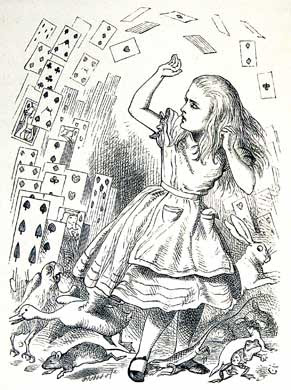Alice’s Adventures In Wonderland, 1865.
(Images Courtesy of University Of British Columbia’s Alice 100 Collection.)
The release of Tim Burton‘s feature film version of Alice In Wonderland in March, 2010 has returned media focus to Lewis Carroll‘s 1865 classic tale once again. And this means that all eyes are also back on the many previous visualizations of the piece, including Sir John Tenniel‘s nonpareil original illustrations. For as the first sentence of the book concludes: “Alice was beginning to get very tired of sitting by her sister on the bank, and of having nothing to do: once or twice she had peeped into the book her sister was reading, but it had no pictures or conversations in it, and where is the use of a book, thought Alice, without pictures or conversations?” Certainly Alice’s Adventures in Wonderland has always been loved by readers and viewers for the many illustrations and images that augment and enrich the words, as much as for Carroll’s ingeniously inventive and complex text.
Bob Nixon of the Canadian Broadcasting Corporation (CBC) was prompted by the release of Burton’s film to visit one of the most outstanding library collections of “Wonderlandiana” in the world, held by the University of British Columbia’s Rare Books and Special Collections Department (UBC RBSC.) This collection of nearly 500 books was amassed by Victoria rare book dealer and librarian, R.D. Hilton Smith. It features more than 200 editions of Alice, containing the work of over 80 illustrators (including a calf-bound first edition signed by Alice Liddell Hargreaves). The works were donated to the UBC RBSC in 1965 by the graduating class of 1925, to celebrate Alice’s centennial, and their own 40th anniversary. Together they are known as “The Alice 100 Collection.”
Such a rich collection offers a unique opportunity to compare the many artistic interpretations of the land down the rabbit hole, well past the center of the earth. The place where Alice at first believes she’ll “come out among the people that walk with their heads downwards,” but that turns out to be far “curiouser and curiouser” than she could ever imagine.
The first illustrator of Alice’s Adventure’s In Wonderland was the author himself. But Charles Lutwidge Dodgson (Lewis Carroll’s real name) was at least modest enough to know he was more talented as a writer than an artist. On the advice of a close friend, he hired noted cartoonist Sir John Tenniel to produce drawings for the published version of the book. Unfortunately for Tenniel, the fact that Dodgson already had a precise personal vision of how the characters should look meant that he insisted on giving the artist instruction for each and every picture down to the smallest of details. This nearly drove Tenniel mad, to the point where he initially refused to collaborate with Carroll on the sequel, Alice, Through The Looking Glass. Tenniel’s illustrations remain the standard by which all subsequent visual imaginings of Alice are measured, as Tim Burton remarked:”If you go back to Tenniel, so much of his work is what stays in your mind about Alice and about Wonderland. Alice and the characters have been done so many times and in so many ways, but Tenniel’s art really lasts there in your memory.”
Nonetheless, many artists over the years have been tempted by the incredible imagination of Carroll’s fantastic tale to attempt to make their own mark on the material Tenniel envisioned so brilliantly. Immediately upon expiration of the British copyright for Carroll and Tenniel’s original work in 1907, illustrators lined up to take a crack at the book. (And the first film adaptation was made even earlier: a 12 minute silent version was directed by Cecil Hepworth and Percy Stow in 1903.) To date more than 50 artists have published illustrated versions of Alice, including Charles Blackman, Salvador Dali, Max Ernst, Arthur Rackham, and Ralph Steadman. A few examples of illustrations for the same scene, the last image of Wonderland at the end of Chapter 12, reveal the varied artistic takes on this passage: “‘Who cares for you?’ said Alice, (she had grown to her full size by this time.) ‘You’re nothing but a pack of cards!’ At this the whole pack rose up into the air, and came flying down upon her: she gave a little scream, half of fright and half of anger…”
Any discussion of Alice’s Adventure’s In Wonderland is by definition bizarre, and here are two of the most far-out variants yet devised:
A book version of a 1939 radio play in which Alice’s role is taken on by a spoiled child named Adolf Hitler:
 Dyrenforth, James and Max Kester. Adolf In Bluderland, Illustrated By Norman Mansbridge. Lindon: Frederick Muller, 1939.
Dyrenforth, James and Max Kester. Adolf In Bluderland, Illustrated By Norman Mansbridge. Lindon: Frederick Muller, 1939.
The reproduction of the above image is in no way an endorsement by Book Patrol or its writers of such an egregious misuse of Tenniel’s magnificent illustrations…












